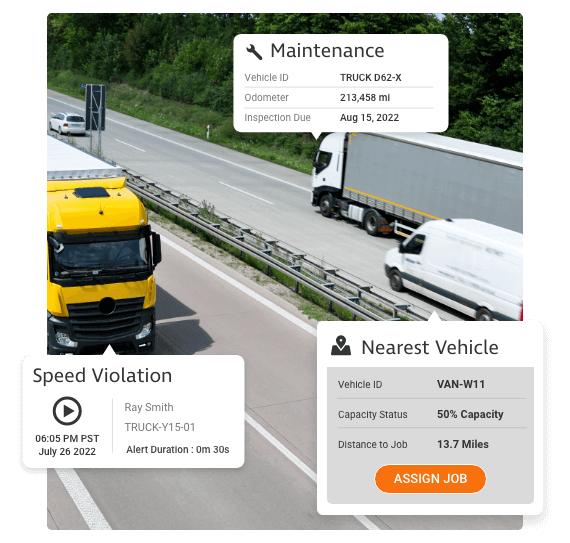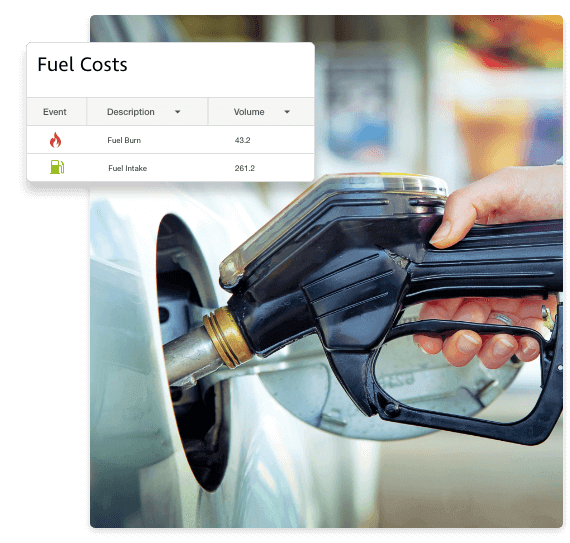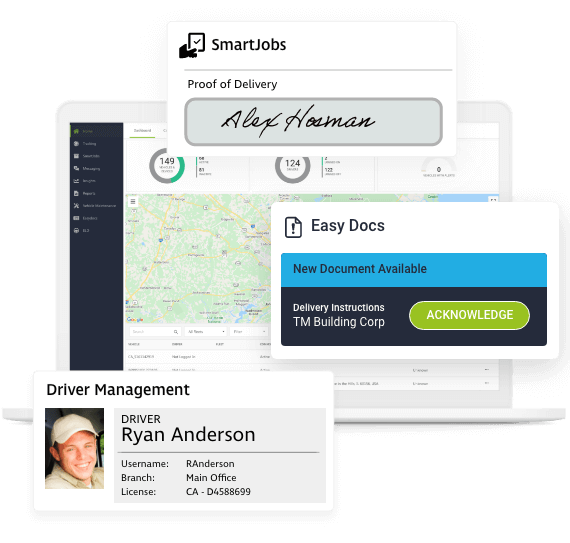Key takeaways
GPS vehicle tracking, also known as telematics, has positively impacted the way many businesses operate. However, many businesses still do not know the full capabilities of the systems or the best ways to implement fleet tracking technology into their own businesses. In this comprehensive guide, we’ll cover everything you need to know about vehicle tracking software and GPS vehicle tracking systems, including what it is, how it works and what you need to know to incorporate fleet tracking technology into your company vehicles.
What is GPS Vehicle Tracking?
GPS vehicle tracking allows you to capture real-time data on your fleet operation. With this information at your fingertips, you can ensure that your business is running efficiently, your drivers are safe on the road and business operating costs are under control.
Unlike previous generations of vehicle tracking systems, today’s GPS fleet tracking goes beyond simple vehicle location and high-level information. Instead, integrated artificial intelligence solutions like those found in TN360 can take raw data and convert it into actionable information to provide key insights into your fleet operations.
Additionally, modern vehicle tracking software is more user-friendly than in the past. From desktop to mobile, software is accessible and intuitive, making it even easier for businesses to stay on top of their fleet logistics.
How Vehicle Tracking Technology Works
Fleet tracking systems use GPS technology to provide location information. Beyond the “eye in the sky,” systems rely on vehicle diagnostic sensors to relay vehicle condition. Driver monitoring systems can also be added to record driver behavior, awareness and fatigue. Together, these systems provide a complete picture of a company vehicle’s status at any given time.
Systems can be broken into six key areas:
- GPS Satellites. The vehicle’s location is reported by a GPS receiver that gathers signals from satellites in orbit.
- Vehicle Monitoring. Onboard data is recorded from driver and vehicle monitoring systems and transmitted via cellular networks.
- Communications. Data transmitted from vehicles is provided using existing telecommunications infrastructure.
- Secure Servers. Data is received and housed on protected servers that can be accessed by authorized users.
- Cloud Storage. Accessible via the internet, businesses are able to access stored data.
- Software Solutions. The end user can observe data in context to make strategic decisions for their fleet via desktop or fleet tracking app.
![]()
Primary Components of a Vehicle Tracking System
Vehicle tracking systems feature an assortment of both hardware and software components working together to deliver a full data picture.
Vehicle Tracking Hardware
Fleet tracking systems require a telematics device capable of collecting and transmitting data via cellular or satellite networks. Devices are designed to capture data points like location, speed and accelerometer readings. Additional sensors can also collect video footage, engine performance and various other metrics that can be used to determine when, where and how a vehicle is being used at any given time.
Hardware can either be professionally installed or self-installed, and each option has its own pros and cons. With professionally installed devices, systems are more likely to feature enhanced security and greater certainty of information accuracy. However, these devices require expert installation which can add cost, whilst taking away the burden of the actual installation process from the owner, fleet manager or user.
With a self-installed system, components are often plug-and-play. These systems usually don’t require a professional install removing that cost from the solution. However the downsides are that systems may be less secure and device tampering may be a concern. While installation is often straightforward, the responsibility for correct setup is left to the party responsible for the vehicle, which may be an issue for less technically inclined individuals.
Fleet Tracking Software
Without software, the raw data collected by telematics hardware cannot be easily understood. It’s only when data is integrated with a smart vehicle tracking software solution that vehicle and driver performance can be efficiently reviewed and acted upon.
Most commonly, fleet tracking software uses a software as a subscription (SaaS) model. This cloud-based software solution allows businesses to customize their software package as needed while paying for access on predetermined licensing terms. This software model also allows for faster updates, more advanced security measures and greater flexibility with implementation.
Rather than needing to hold on to an aging software system or working through an in-depth and costly software upgrade, SaaS software offers users a simple, cloud-based fleet management solution with lower long-term costs, more simplicity in design and added features like mobile applications.
GPS Fleet Tracking Technology for Business
The large amount of data generated by vehicle tracking systems can provide a better overall picture of how fleet vehicles are being used. However, this data is only useful if it can be used strategically. Here are some of the key ways businesses use fleet vehicle tracking systems
Common Uses for Vehicle Tracking GPS
On their own, individual data points may be useful, but when used together, owners, fleet managers and even drivers can benefit from vehicle tracking technology. Here are just a few examples:
- With engine sensors and location tracking, it’s possible to determine if a vehicle is being operated outside of work hours or away from a known customer sites. This can prevent theft or unauthorized use.
- By using vehicle location and speed sensors, driver speeds can be monitored to ensure compliance with posted speed limits. This can prevent potential driver infractions or costly safety liabilities.
- With accelerometers and in-vehicle monitoring systems (IVMS), actions like hard braking can be reviewed to determine if drivers were distracted, drowsy or otherwise impaired. This can protect both drivers and companies from liability in the event of an accident. It can also allow potentially dangerous driving habits to be addressed ahead of time to decrease the likelihood of accidents altogether.
- Having access to accurate driver hours data enables jobs to be assigned to drivers without putting them at risk of a violation.

These are just a few of the many of the ways in which vehicle tracking systems can be employed. Additional data can also be used to prepare for vehicle maintenance, and efficiently plan routes for better fuel usage, as well as other applications important to your business needs.
Industries Using Vehicle Tracking Systems
Fleet vehicle tracking systems are commonly used across a wide range of industries, including many that aren’t often associated with the technology. Here are some of the industries where vehicle tracking technology is found, and how the systems are used:
- Commercial Fleets. Industries like trucking have long used vehicle tracking software to manage assets. Vehicle usage, compliance management, maintenance schedules and logistical planning are all made more efficient using tracking systems.
- Service Fleets. Vehicle information can be viewed real-time to ensure resources can deliver services on time and on location to improve customer satisfaction while ensuring driver safety.
- Companies use the insights provided through telematics to manage on road vehicles and off road assets, with data used to improve utilization, reduce rental costs and improve project bidding.
- Retail and Manufacturing. Vehicle tracking software can drive down overhead costs, which can then be passed on to customers to make products more competitive in the marketplace.
- Fleet tracking software can ensure donors' dollars do the most good by reducing overhead costs. Less money spent on operations means more dollars spent on communities in need.
- Vehicle tracking software allows for better compliance with strict public sector regulations. Additionally, voter mandates for “greener” operations can be addressed through increased efficiency and a smaller carbon footprint.
- Passenger Service. Customers rely on timely transport services. Additionally, the safety of both drivers and passengers is a primary concern, and monitoring software helps maintain safer riding conditions.
- Mining, Oil and Gas. Resource extraction timelines need to stay on schedule, and fleet management systems allow for better asset utilization. These systems also help prevent unauthorized use of equipment.
Should I Use a GPS Vehicle Tracking System for My Business?
Businesses big and small can benefit from vehicle tracking systems. Whether or not you decide to implement GPS fleet management for your business will likely depend on your organizational goals.
Improve Safety for Drivers and Passengers
Driver safety is a primary concern for all businesses operating vehicles. The nature of the business opens up the door for potential liabilities in the form of unsafe drivers or dangerous operating conditions. By implementing vehicle tracking systems, businesses can get a better picture of how vehicles are being used on a daily basis. This protects the business from liability, keeps drivers and other road users safe and can result in reduced insurance premiums.
Create a Culture of Accountability
If you’re looking to make sure everyone in your organization I focused on its objectives, vehicle tracking software can help by creating a culture of accountability. All parties will have clear performance metrics and can keep track of personal and organizational goals. Operators who are underperforming can receive the additional training and guidance they need to meet their full potential. On the other end of the spectrum, talented operators will be able to stand out among their peers.
Lower Operating Expenses for Businesses
One of the biggest benefits to vehicle tracking software is lower operating expenses. By making operations more efficient, decreasing wear and tear on vehicles, and preventing theft or misuse of resources, businesses can increase profits or lower costs for customers while maintaining margins.

Process Digitization
Technology continues to advance at a rapid pace, and companies unable to adapt to the times will struggle going forward. Vehicle tracking technology can help companies with the digital transformation process by simplifying many of the outdated processes currently used for route planning, maintenance scheduling, and other day-to-day operations.
Simplify Compliance
IFTA, DVIR, and driver hours all require detailed information to maintain compliance. Attempting to track this information manually leads to a high incidence of errors and missed information. By implementing vehicle tracking technology, most or all items on a fleet compliance checklist can be automated to save time and create more efficient workflows.
How to Implement a Vehicle Tracking System into Your Business
Vehicle tracking systems come in many forms and at many different price points. This means there’s no one-size-fits-all solution. Owners, fleet managers or those responsible for selecting the best vehicle tracking system for their needs will need to be aware of their options on the market and their goals for the technology.
How to Select the Best Fleet Tracking GPS System for Your Needs
There are many considerations that will need to be made before deciding on the best fleet tracking software for your organization. Here are a few of the most common details to consider:
- What is your business looking to spend? Keep your organization’s desired spend in mind, but also remember that a properly implemented system can lower operating costs.
- Evaluate Your Needs & Features. While nearly all vehicle tracking systems will include features like real-time tracking, some level of driver monitoring and onboard diagnostics, you will need to know what your business requirements are. You can configure your custom solution here to get a better understanding of your options.
- Your needs today will not be the same as your needs in the future. Will your vehicle tracking system grow with your business? Scalability isn’t about predicting the future, but ensuring that your software has the ability to adapt to your changing needs.
- Implementation Downtime. Putting a new system into place can take time and energy. You will not only need to consider the time required to install devices, but also the time to train employees on new software.

Tips for Implementing a Vehicle Tracking System
Before putting a vehicle tracking system into place, you’ll need to understand and be able to clearly explain why such a system is necessary. Without this justification, the employee buy-in process will be much more difficult.
Employee buy-in alone is not enough, however. Even employees who have been convinced of the benefits of vehicle tracking software will need ongoing support and training to ensure their experience with the technology is a positive one. Create a simple and effective onboarding program and be sure to adapt and adjust as needed. By maintaining flexibility and getting your team to embrace fleet tracking technology, you’ll be able to reap the full benefits of a comprehensive telematics system.
Additional Resources
To learn more about vehicle tracking systems and related technology, check out the Teletrac Navman resource library. You can also explore our customer stories to see the different ways GPS vehicle tracking systems are being leveraged by companies big and small around the world.
If you’re ready to implement a customized solution of your own, use this online tool to see how our platform can transform your business based on your needs.

